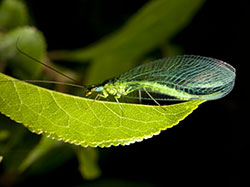Think twice before using pesticides
Overuse of pesticides (weed and bug killers) can damage soil and plant health, poison wildlife like birds and salmon, and harm our families’ health. The good news is that we really don’t need most of those chemicals. Try these natural methods first.
Start with prevention
Healthy plants are naturally more resistant to pests and disease.
- Build healthy soil with compost and mulch – soil organisms protect plants from many disease and insect pest problems.
- Add pest-resistant plants to the sun/shade and soil conditions they like.
- Remove diseased plants, and compost dead plants in fall to reduce hiding places for insect pests.
- Pull weeds before they distribute their seeds and spread.
- Use a variety of plants, so if pests attack one plant, other plants can fill its place.
Identify the problem before you spray, squash, or stomp
The problem could really be incorrect mowing or pruning, improper watering, or other easily corrected practices. Or that scary bug could be a beneficial “good bug” that eats problem pests. Whether it’s a bug, disease, or weed, you need to identify it to know how to effectively manage it.
Accept a little damage – give nature time to work
Natural predators kill pests, but they need time to work. Don’t spray at the first sign of plant damage – nature may control it for you, or nearby plants may out grow the damage.
If a pest or weed problem develops, use the least toxic solution
- Physical controls like traps, barriers, fabric row covers, or repellants may work
- Long-handled weed pullers pop dandelions out easily.
- Mulching once a year reduces weeds
- Less toxic products like soaps, horticultural oils, and plant-based insecticides are now available.
- Beneficial insects are available for sale, or you can attract these “good bugs” by planting a variety of plants that provide pollen and nectar all year.
Use chemical pesticides as the last resort
If you must use a chemical pesticide, use the least toxic product, and spot spray it – don’t spread it all over the yard to kill a few weeds or bugs. It may be best to have a professional do the application, but don’t use services that spread chemicals over the whole yard or spray on a calendar schedule. You want to apply pesticides only when and where you really have a problem. Follow label instructions exactly – more is not better. And be sure to keep children and pets out of application areas.
Replace problem plants with pest-resistant ones for a healthier, easier-to-care-for yard
If a plant, even a tree, has insect pest or disease problems every year, it’s time to replace it with a more pest-tolerant variety, or another type of plant that doesn’t attract the pest.
Got a tough pest or weed problem? Help is only a call away
Call the Garden Hotline at (206) 633-0224 or email help@gardenhotline.org for free brochures, expert help in identifying “good bugs”, and solving your insect pest, weed, or plant disease problem.
More Information
Natural Pest, Weed & Disease Control guide (pdf)
Natural Yard Care guide (pdf)
El Cuidado Natural del Jardín (pdf)
Alternative Pest & Weed Control Methods (pdf)
Grow Smart Grow Safe website lists safer products
Links to Other Sites
Integrated Pest Management has factsheets on common pest problems and effective, less toxic solutions.
UPEST – Washington State University information on indoor and outdoor integrated pest management for schools and households
UC IPM – University of California integrated pest management solutions for landscapes and agriculture
NCAP – Northwest Coalition for Alternatives to Pesticides – advocacy and science-based alternatives factsheets
